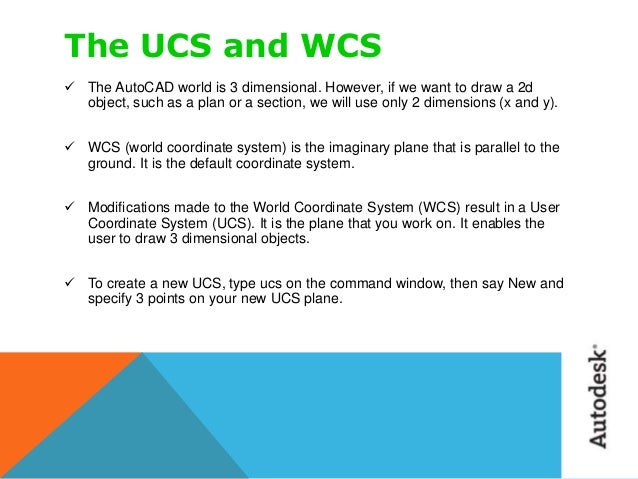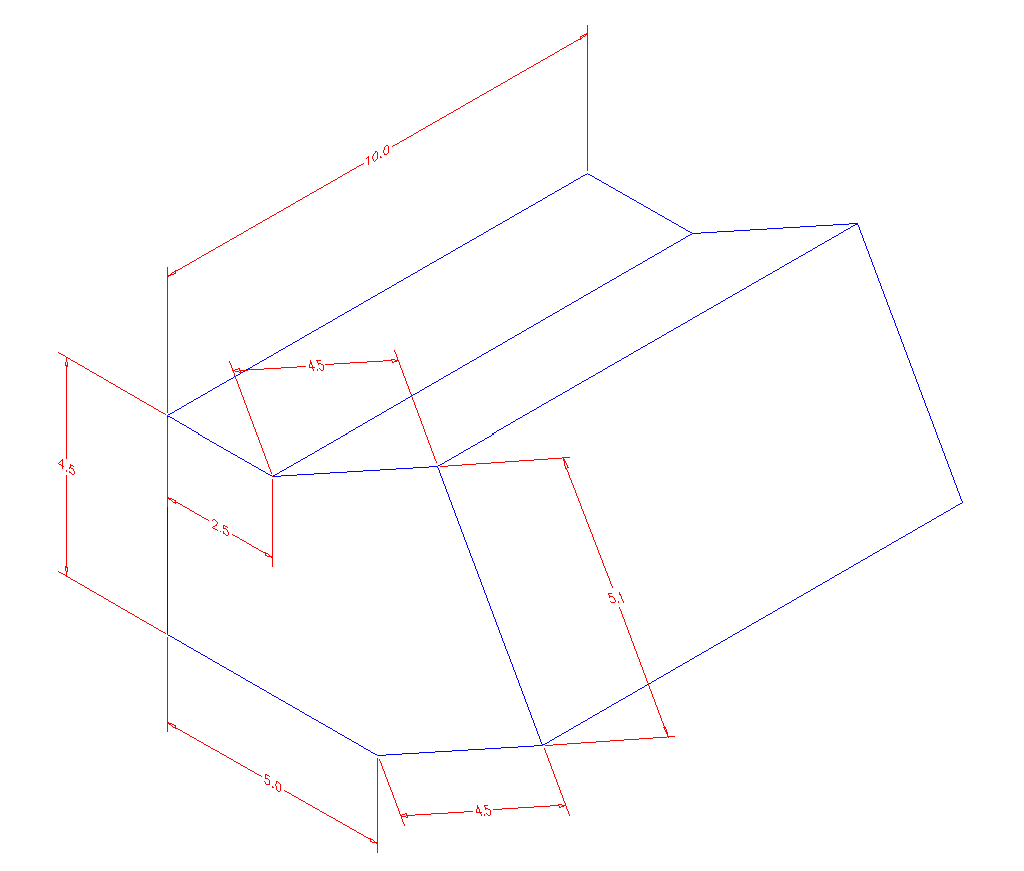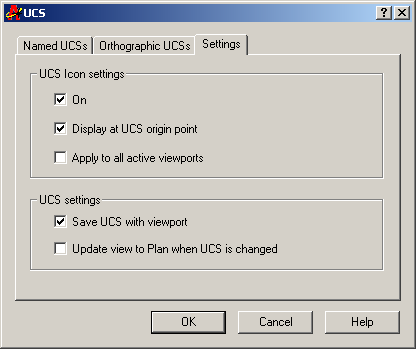- Differentiate Between Ucs And Wcs In Autocad Download
- Differentiate Between Ucs And Wcs In Autocad 2013
- Differentiate Between Ucs And Wcs In Autocad Free
- Differentiate Between Ucs And Wcs In Autocad Free
- Differentiate Between Ucs And Wcs In Autocad 2015
Understanding the World and User Coordinate systems in AutoCAD
An demonstration of the WCS (World Coordinate System) and the UCS (User Coordinate System) in Autocad. May 09, 2019 Goes to the plan view of the World Coordinate System. AutoCAD Help Topics for New UCS. To differentiate these two types of surfaces, AutoCAD calls faceted. To switch back and forth between the two UCSs, simply select the one you want to use from the Coordinates panel: Use WCS: On the Coordinates panel of the Home tab, choose UCS, World. All objects in a drawing are defined by their coordinates in the World Coordinate System (WCS), a permanently fixed Cartesian coordinate system. The UCS is initially coincident with the WCS in new drawings. The squares in the lower-left corners of each of the icons indicates that the UCS icon is currently coincident with the WCS.
Differentiate Between Ucs And Wcs In Autocad Download
The World Coordinate System is based on the Cartesian Coordinate System. Having an understanding of this coordinate system (which many people have, despite of probably never heard of the name) is essential to understanding how the WCS (and UCS) work within AutoCAD. Some of what is written below (quotes) I have taken from the AutoCAD 2010 Users Guide.
There are two coordinate systems: a fixed system called the world coordinate system (WCS) and a movable system called the user coordinate system (UCS). By default, these two systems are coincident in a new drawing.

Differentiate Between Ucs And Wcs In Autocad 2013
Normally in 2D views, the WCS X axis is horizontal and the Y axis is vertical. The WCS origin is where the X and Y axes intersect (0,0). All objects in a drawing file are defined by their WCS coordinates. However, it is usually more convenient to create and edit objects based on the movable UCS.
By default when you start a new (blank) drawing you use the World Coordinate System (WCS). This is your (0,0,0) point. Looking at the UCS icon, the square in the crosshairs tells you, you are using the World Coordinate System. This is also clear when looking below the compass. In the screenshot below you can see the WCS is active. When clicking on arrow it shows you have the WCS active and gives you the option to create a new User Coordinate System (UCS).

How to work with the User Coordinate System?
Virtually all coordinate entry as well as many other tools and operations reference the current UCS. 2D tools and operations that depend on the location and orientation of the UCS include the following:
- Absolute and relative coordinate entry
- Absolute reference angles
- Definition of horizontal and vertical for Ortho mode, polar tracking, object snap tracking, grid display, and grid snap
- Orientation of horizontal and vertical dimensions
- Orientation of text objects
- View rotation using the PLAN command
Differentiate Between Ucs And Wcs In Autocad Free
Moving or rotating the UCS can make it easier to work on particular areas of a drawing.
You can relocate the user coordinate system with methods such as the following:
- Move the UCS by defining a new origin point.
- Align the UCS with an existing object.
- Rotate the UCS by specifying a new origin point and a point on the new X axis.
- Rotate the current UCS a specified angle around the Z axis.
- Revert to the previous UCS.
- Restore the UCS to be coincident with the WCS.
Each of these methods have a corresponding option in the UCS command. Once you have defined a UCS, you can name it and then restore it when you need to use it again.


Differentiate Between Ucs And Wcs In Autocad 2013
Normally in 2D views, the WCS X axis is horizontal and the Y axis is vertical. The WCS origin is where the X and Y axes intersect (0,0). All objects in a drawing file are defined by their WCS coordinates. However, it is usually more convenient to create and edit objects based on the movable UCS.
By default when you start a new (blank) drawing you use the World Coordinate System (WCS). This is your (0,0,0) point. Looking at the UCS icon, the square in the crosshairs tells you, you are using the World Coordinate System. This is also clear when looking below the compass. In the screenshot below you can see the WCS is active. When clicking on arrow it shows you have the WCS active and gives you the option to create a new User Coordinate System (UCS).
How to work with the User Coordinate System?
Virtually all coordinate entry as well as many other tools and operations reference the current UCS. 2D tools and operations that depend on the location and orientation of the UCS include the following:
- Absolute and relative coordinate entry
- Absolute reference angles
- Definition of horizontal and vertical for Ortho mode, polar tracking, object snap tracking, grid display, and grid snap
- Orientation of horizontal and vertical dimensions
- Orientation of text objects
- View rotation using the PLAN command
Differentiate Between Ucs And Wcs In Autocad Free
Moving or rotating the UCS can make it easier to work on particular areas of a drawing.
You can relocate the user coordinate system with methods such as the following:
- Move the UCS by defining a new origin point.
- Align the UCS with an existing object.
- Rotate the UCS by specifying a new origin point and a point on the new X axis.
- Rotate the current UCS a specified angle around the Z axis.
- Revert to the previous UCS.
- Restore the UCS to be coincident with the WCS.
Each of these methods have a corresponding option in the UCS command. Once you have defined a UCS, you can name it and then restore it when you need to use it again.
O saiba o saiba song. For instance: If you want to set a drawing to a newly determined zero-point, so you can use that particular point as the starting point for a coordinate system you need to use, you can just move the UCS to that new point. That point will then be the (0,0,0) point. You can even change the UCS angle if that is required. You can name them and save them, so you can switch between them. In Paperspace you need to keep in mind that the UCS only has a (0,0) point: An ‘X' and a ‘Y' coordinate.
When moving the UCS origin (see pictures below) you can see the square in the crosshairs is gone, meaning you use the User Coordinate System. Instead of seeing WCS underneath your compass you now see ‘Unnamed', meaning your active UCS is still unnamed.
To save your newly determined UCS do the following:
- Click View tab>UCS panel>Named UCS. The new UCS is displayed in the UCS list as UNNAMED.
- In the UCS dialog box, Named UCSs tab, select UNNAMED and enter a new name. (You can also select UNNAMED, and right-click. Click Rename.)
- Click OK. You can use up to 255 characters, including letters, digits, and the special characters dollar sign ($), hyphen (-), and underscore (_). All UCS names are converted to uppercase.
When you have determined a new UCS origin, and want to switch back to the World Coordinate System, you need to save you new UCS before you switch. Otherwise the new point UCS point will be lost.
There is much, much more to say about the UCS system, but these things are just the basics. Of course the command to use to manipulate your UCS is:
Differentiate Between Ucs And Wcs In Autocad Free
UCS
Differentiate Between Ucs And Wcs In Autocad 2015
This will give you all sorts of options (to move, rotate, name, etc.) for your UCS.
The Webex button or toolbar is missing from Outlook for Mac Mojave. To enable Webex Plug-in: Click on the apple icon at the top-left of your screen, then select System Preferences. Mar 20, 2020 Webex Integration to Outlook for Mac Overview. Learn how to configure the Webex integration to Microsoft Outlook using Cisco Webex Productivity Tools on your Mac. Once you have installed the Webex integration to Outlook, you can join and schedule meetings, change your preferences, and more. Dec 09, 2019 Webex Productivity Tools has two separate packages for WBS39.10 and later versions. Productivity Tools supports integrations with other applications, such as Microsoft Office (Word, Excel, and PowerPoint), Microsoft Skype for Business, Microsoft Lync, Internet Explorer, and IBM Lotus Notes. To make joining and creating Webex meetings easier, you can install Webex Productivity Tools on your Mac. Webex outlook plugin for mac.
